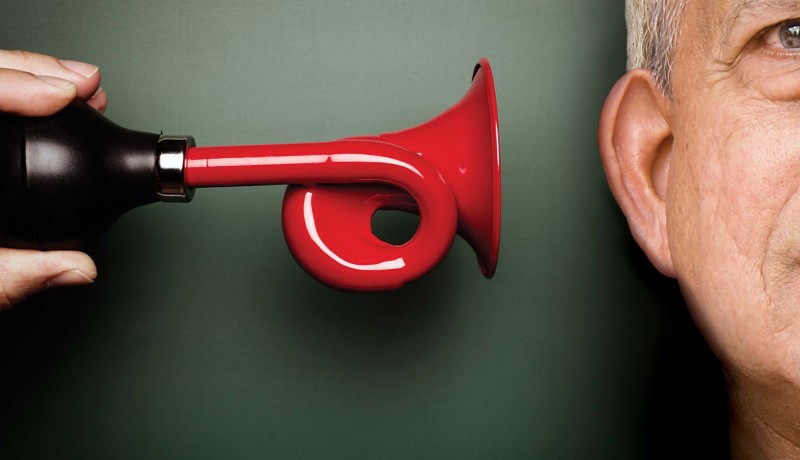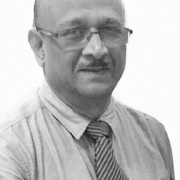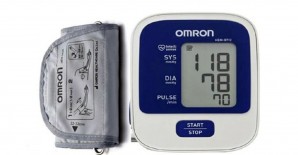
Health

Though hearing impairment is the second most common illness in silvers, digitalised miniature hearing aids available today amplify not just sound but quality of life, writes Srirekha Pillai
The quiet Nair household in Kochi transforms into a virtual battle zone with frayed nerves every evening as the head of the family, 87 year-old Krishnan Nair, switches on the TV to catch his daily dose of news. While he has a hard time following the happenings even at a high decibel level, for others in the family it’s a test of auditory endurance levels, resulting in a tug of war between Nair and others for the remote to control the audio.
Constantly turning the television volume up could be just one of the alarming signals in silvers to watch out for (‘DIY test’, page 46) when it comes to hearing impairment (HI). Though an invisible handicap, the effects of HI upon a person’s health, happiness and well-being are very real and even potentially dangerous. The dangers, however, are not purely physical such as not being able to hear honking vehicles while crossing roads or a fire alarm, but even psychological, with patients often tending to withdraw from social interactions, leading to depression. Given the gravity of the problem, it’s no surprise that deaf-blind American author and activist Helen Keller said, “Blindness cuts us off from things, but deafness cuts us off from people.”
How & why?
The World Health Organisation’s (WHO) definition of ‘deafness’ refers to the complete loss of hearing ability in one or both ears. Hearing loss occurs when the tiny hair cells inside our inner ear—which help us hear by picking up sound waves and changing them into nerve signals for the brain—are damaged or die. As the hair cells do not re-grow, hearing loss caused by hair cell damage is permanent. Hair cells are most commonly destroyed by the changes in the inner ear as one grows old. Genes and exposure to loud noise can aggravate and quicken the damage.
World over, presbycusis or age-related hearing loss, which is progressive and irreversible, is the most common cause of hearing loss, afflicting one out of three persons by age 65, and one out of two by age 75. In fact, presbycusis is the second most common illness, next only to arthritis, in silvers. A global survey by the WHO in 2012 estimated that over 164.5 million people above the age of 65—about one-third—suffered from hearing loss. The prevalence was the highest in Sub-Saharan Africa, Asia Pacific and South Asia.
However, experts say there is no need to press the panic button yet. In fact, WHO notes that almost half of the causes of HI are preventable; and about 30 per cent, though not treatable, can be managed with assistive devices.
India talk
The major causes of hearing loss and ear diseases in India as identified by a WHO survey are earwax (15.9 per cent), presbycusis (10.3 per cent), middle ear infections, dry perforation of tympanic membrane and congenital deafness. What makes treating HI a huge challenge in India is the lack of skilled manpower and human resources. In fact, a WHO study raised concerns over the acute shortage of human resources to address the issue of deafness in India. The study listed the estimated number of ENT specialists and otologists in India as 7,000 and 2,000 respectively. It also found the audiometrist-to-population ratio to be an alarming 1:500,000, and the ratio of speech therapist to the deaf population to be 1:200.
The most common form of hearing loss—affecting one in four people over 65—is sensorineural (nerve) hearing loss, caused by constant exposure to loud noises, illness, injury or infection, damaging either the auditory nerve that controls hearing or the hair cells in the ear that help transmit sound. Moreover, as the nervous system becomes old, it finds it difficult to process the audio signals. A less common cause is conductive hearing loss, caused by earwax or fluid build-up, and even a punctured eardrum. While conductive hearing loss can often be corrected by treatment, sensorineural hearing loss can’t be reversed and has to be treated with hearing aids and cochlear implants.
Aid at hand
A hearing aid is an electro-acoustic device worn inside or behind the ear, and is used to amplify sound. It comprises a microphone, amplifier and speaker. The sound waves received by the microphone are converted to electrical signals and sent to the amplifier, which amplifies the power of the signals and sends them to the ear through a speaker. Earlier, silvers could be seen sporting hearing aids that were huge and looked like ‘plugs’. These hearing aids had to be adjusted constantly to match the sound of one’s ambient environment. Urvashi Malhotra, a Bengaluru-based content developer for websites, recalls hearing whistles and buzzes coming out of her grandfather’s device. “I remember Dadaji constantly adjusting the hearing aid so he could hear right and tune out the background noise,” she reminisces. Research and development in recent years, however, has led to technological transformation in the hearing aid marketplace, making a significant difference in the lives of millions.
The state-of-the-art hearing aids available today are so sleek and virtually invisible that it’s not easy to guess you are wearing one. These models comprise a microcomputer that responds effectively to noise in the environment, cutting back echoes, filtering out background noise and automatically adjusting the volume. Being waterproof, they can even be worn underwater. Digital, discreet and wireless, they can be connected to smartphones and the TV. Most are computer-programmed to match the nuances of a particular person’s hearing loss. Whether they stay inside your ear canal or wrap around the contour of the outer ear, these tailor-made, high-performance aids amplify not just sound but quality of life.
Anup Narang, director of Delhi-based ALPS, manufacturers of digital hearing aids in India with a market in 30 countries worldwide including America, Asia and Africa, points out that the latest trend abroad and in India is miniaturised hearing aids, which are hi-tech digital products. “Digital hearing aids connect silvers to Bluetooth devices, laptops, music players and television, allowing them to connect to life,” he explains. Besides quality, pricing sets desi digital aids apart. “While a hi-tech hearing aid would cost around ₹ 100,000 abroad, it would be available in the Indian market for ₹ 30,000 to ₹ 40,000,” he adds.
Different problems, different styles
Hearing aids come in different sizes, styles, power and circuitry. People with severe hearing loss often need a larger size to accommodate the added circuitry and wires. The position of the hearing aid—behind or inside the ear—is determined by its size.
In-the-ear (ITE): Used for mild to severe hearing loss, these fit completely in the outer ear. They are custom-made to fit an individual. On the flip side, they can be damaged by earwax and ear drainage, and the tiny size can cause minor adjustment problems.
Behind-the-ear (BTE): As the name suggests, they are worn behind the ear and come with a case and ‘earmold’ or dome. The case, equipped with electronics, controls, battery, microphone and loudspeaker, is connected to a plastic earmold that fits inside the outer ear. These are used by people with mild to profound hearing loss. As they are fitted behind the ear, there is no chance of any damage from moisture and earwax. However, if not fitted properly, they produce a whistling sound. Interestingly, BTE aids can be connected to Bluetooth cell phone technology, enabling the wearer to hear directly from the phone, cutting out background noise. A new kind of BTE aid is an open-fit hearing aid that fits behind the ear completely with only a narrow tube inserted into the ear canal, enabling the canal to remain open.
Canal aids: They fit into the ear canal and are available in two styles. The in-the-canal (ITC) is customised to fit the size and shape of the ear canal. A completely-in-canal (CIC) hearing aid is neatly hidden in the ear canal. Though extremely popular as they are invisible and give a more natural experience of hearing with comfort, they may be difficult for the user to adjust and remove because of the small size. There is also danger from the build-up of earwax. They are used for moderately severe hearing loss.
Cochlear implants: A surgically implanted electronic device that provides a sense of sound to those with severe hearing loss, cochlear implants comprise a microphone, speech processor and a transmitter placed behind the ear and an array of electrodes in the cochlea, the auditory portion of the inner ear. Sound waves picked up by the implant are converted into electrical energy and fed to the brain, which in turn perceives it as sound. If the hearing loss is severe, doctors recommend a cochlear implant in one or both the ears.
Cochlear or not?
Different from a hearing aid, a cochlear implant—which can set one back by ₹ 600,000 to ₹ 800,000— bypasses the damaged portions of the ear to directly stimulate the auditory nerve. Hearing with the help of a cochlear implant is different from normal hearing and takes time to learn.
Dr Ashok K Sinha, director of Ali Yavar Jung National Institute for Hearing Handicapped (AYJNIHH) in Mumbai, points out that when it comes to cochlear implants for silvers, one has to tread with caution. “Cochlear implants are recommended for silvers only after proper medical and audiological examination by an ENT specialist. Sometimes what we perceive as a hearing problem in a silver may be a perceiving problem—of not being able to understand and correlate what is being implied—suggesting neural degeneration in the brain. In such cases, cochlear implants don’t work,” he says.
Madhuri Gore, principal and head of the Department of Audiology, Dr S R Chandrashekhar Institute of Speech & Hearing, Bengaluru, concurs. She recommends cochlear implants for silvers only “if the degree of loss is so bad that they can’t hear with hearing aids and only if their general health is good”. Recalling how a 65 year-old got an implant done recently because he didn’t want to compromise his independence, Gore points out that educated and socially aware individuals are more open to seeking treatment. “With the sophisticated and advanced technology available today, the quality of hearing aids has improved drastically,” she says. “Hence, there’s no need to shy away from them.” Gore recalls how her grandfather gave up wearing his clumsy hearing aid after trying it just once. “He told us he was better off without it!” she smiles, adding, “That was in the 1970s. Now, of course, the scene is different.”
However sophisticated they might be, adjusting to a new hearing aid is not a cakewalk. Besides minor discomfort, background noise, and whistling sound, the ‘plugged up’ sensation can cause the wearer’s voice to sound louder inside the head.
Desi initiatives
Keeping up with the trend of desi low-cost innovation in different spheres, whether it is the Nano or Aakash tablets, the Centre for Development of Advanced Computing (C-DAC) has developed affordable hearing aids under project ‘Tarang’. The project has been partnered by premier institutes such as the All India Institute of Medical Sciences, CMC Vellore, and the All India Institute of Speech and Hearing, Mysuru. “Tarang has been a massive success,” says Biju Oommen, associate director and group head of the Hardware Design Group, C-DAC, Thiruvananthapuram. “People order aids from our website and get them programmed from our audiologist or go to one of our partner institutes.” Though the C-DAC website—www.cdac.in—is the primary contact for buying Tarang, the technology is in the process of being transferred to Delhi-based Best Hearing Solutions and the Kerala State Electronics Development Corporation Limited (KELTRON). Available in two models—body worn (₹ 4,773) and behind-the-ear (₹ 5,340)—Tarang uses digital signal processing techniques. Hearing devices with similar features sell in the market in the price range of ₹ 10,000 to ₹ 100,000.
The imported cochlear implants, which have been available in India for almost two decades now and cost ₹ 700,000 to ₹ 1 million, are also being indigenously developed in Defence Research and Development Organisation (DRDO) labs. The price of these bionic ears, ‘Sravan’, is expected to be in the range of ₹ 100,000 to ₹ 150,000, thus benefiting thousands suffering from severe HI. Developed by Defence Bio-Engineering and Electro-Medical Laboratory (Debel), a unit of DRDO in Bengaluru, Sravan is undergoing field trials and should be ready to roll out soon.
Government measures
For its part, the Government of India launched the National Programme for Prevention and Control of Deafness in 2007 to combat hearing impairment. Implemented at the primary healthcare level, this programme envisages early identification, diagnosis and treatment of ear problems leading to deafness and focuses on training medical personnel. Initiated on pilot mode in some states and union territories, it aims to cover the entire country by 2017.
Meanwhile, AYJNIHH, an autonomous organisation under the Ministry of Social Justice and Empowerment, disburses digital programmable BTE hearing aids to those with a family income of less than ₹ 15,000 per month under the Assistance to Disabled Persons for Purchase/Fitting of Aids and Appliances (ADIP) scheme. This scheme is open to all age groups.
The way forward
Statistics show that only one out of five people who would benefit from a hearing aid actually use one. Among the reasons could be factors ranging from social stigma attached with wearing a hearing aid to prohibitive costing of digital hi-tech aids that are all the rage now.
Reinforcing this surmise is Kolkata-based Babul Basu, who treats geriatric psychological issues related to hearing impairment. “Silvers are hesitant to spend on themselves. They are also apprehensive about wearing hearing aids for fear of marring their appearance,” he says. “They need to realise that the right treatment at the right time can make them not only confident but also independent.” He sees support groups—family or friends—as a key factor in motivating silvers to seek treatment.
Recalling how a prominent city judge’s wife was pulling out from her social circle because of severe hearing impairment, Basu points out that her friend convinced her to attend counselling and seek treatment. “Today, the lady has an active social life, and wants to go in for a hearing aid for her second ear too. What’s more, she has managed to convince her husband, who earlier had misgivings, to go in for one,” he chuckles.
Spreading awareness about the need to treat hearing loss at an early stage is imperative not just to derive optimal benefit from hearing aids but prevent other systematic disorders such as stress, diabetes and hypertension and to arrest dementia. A holistic and comprehensive approach that involves government, medical personnel and society at large is the need of the hour to reduce the burden of deafness in India and arrest further deterioration.
Hearing loss accelerates dementia and cognitive deficits: Prof Rangasayee Raghunathrao
How alarming is the issue of hearing impairment in India?
According to the 2011 census, over 5 million people suffer from hearing impairment in both ears. According to the data, of the 5,071,007 cases, 2,677,544 are males and 2,393,463 are females. These figures comprise those who suffer from moderate to severe hearing loss.
Is there a serious urban-rural dichotomy?
Over 70 per cent of these cases have been reported from rural areas. More than any other factor, it’s largely owing to the fact that the majority of India still lives in villages.
How serious is the issue among silvers?
Roughly 40 per cent of silvers have difficulty in hearing. It has been found that silvers seek treatment for hearing loss only if hearing tone exceeds 60 dB (decibel). Hearing in the range of 0-20 dB is considered normal. Most silvers have 40 dB hearing, which is considerable and has to be taken seriously. But they avoid seeking help until it worsens to 60 dB, which is alarming.
What are the repercussions of not getting treated?
It’s a proven fact that hearing loss in silvers accelerates dementia and cognitive deficits. It also leads to third-party disability, affecting other members of the family and caregivers. Communication breakdown with significant members of the family owing to hearing loss can lead to other systematic disorders such as stress, diabetes and hypertension. Communication breakdown can also lead to the neglect of silvers.
What has the Government’s stance been?
The Maintenance and Welfare of Parents and Senior Citizens Act 2007 does take care of a lot of these issues. Hearing is a public health issue because of its insidious nature. It’s unfortunate that while blindness and other conditions have been treated so vigorously, hearing impairment hasn’t got the same attention. I think it’s more of a societal problem. There’s more stigma attached to wearing a hearing aid than glasses. Sporting a hearing aid is seen as a sign of ageing. We need to realise that untreated hearing impairment can lead to cognitive load, with more energy being consumed. However, successive governments have done what they could by providing free hearing aids under the Assistance to Disabled Persons for Purchase/Fitting of Aids and Appliances (ADIP) scheme. The National Policy for Persons with Disabilities in 2006 provides enough and more scope for meeting the needs of such people.
Does it include spreading awareness too?
The ADIP scheme has an inbuilt awareness programme. Special efforts are also undertaken by the Ministry of Disability Affairs to create awareness about welfare schemes. I feel the reach could grow manifold if awareness material is in an accessible format such as sign language, text versions, etc. The Accessible India Campaign launched in 2015 meant to create access for the differently abled community is also a good beginning. But to empower them, one needs to ensure participation.
What are the schemes you have pioneered?
We created an empowered town panchayat in Kulgaon-Badlapur in Thane district. Today, all the parks, railway stations and public places in this town panchayat are accessible for the disabled. The major hospital in the area has ramps and an induction loop system to help the hearing-impaired. There is a talking level crossing in front of a blind school in the area. Even the cinema halls there have three seats reserved for the disabled. In 2003, the town panchayat received the Barrier-Free Panchayat Award from the President of India. It’s a self-sustained programme and runs on just ₹ 10 collected per household per year.
We were able to commercialise a low-cost cross hearing aid invented by one of my colleagues from Kolkata. We also formulated, finalised and introduced sign language interpreter and instructor courses, auditory verbal therapy for post-cochlear implant training, a postgraduate diploma in media and disability communication (Mumbai University), and a PhD in audiology and speech-language pathology in universities. We also designed the first accessible website in the country in 2007, which received a national award in 2010. My team developed a low-cost assistive noise level indicator for facilitating communication in hearing-impaired children. Our censor-certified national anthem in universal design won an international award. The Indian anthem is the only one in the world in universal design!
Is the Government-run free hearing aid scheme beneficial?
The Government has made hearing aids accessible and affordable. I only wish post-fitment training, showing clients how to handle them, could be strengthened for maximum benefit.
Dr Rangasayee Raghunathrao is director (technical) and professor at Dr S R Chandrasekhar Institute of Speech and Hearing, Bengaluru. He was president of the Indian Speech and Hearing Association in 1985-86 and 2014-15. He also served as director of the Ali Yavar Jung National Institute for the Hearing Handicapped (AYJNIHH) from 2001 to 2013
Patients often don’t realise the severity of the problem: Dr Anirban Dasgupta
What causes hearing impairment?
Hearing loss can happen owing to anatomical, physiological, psychological and social reasons. Anatomical causes include accidental trauma, deformities of the ear since birth, fluid formation, dryness of the inner ear, extra bony growth, external deformities or absence of the outer ear and blockage of the nose. Physiological reasons include ageing, viral attack, nerve problems, change in physiological or biological conditions within the body, and medicine or treatment for health hazards such as malaria, encephalitis, cancer, tuberculosis, stroke, etc. Psychological factors comprise depression, shocks and mental blocks. Social status and cosmetic reasons can affect the acceptance of hearing loss and worsen its severity in the long run.
What are the warning signs to watch out for?
The warning signs are: sound becomes muffled; asking for repetitions; losing interest in continuous discussions; talking loudly; asking others to speak loudly; turning up the volume of radio, television, and CD players; a ringing sound in the ear (tinnitus); irritability; avoiding phone calls; pronunciation errors; and problems with balance.
What are the latent dangers, both physical and psychological, for someone who refuses to get treated?
Refusal to seek treatment may have serious repercussions in emergency situations; chances of missing honking on busy roads or fire alarms in buildings are high. If hearing loss has been caused owing to nerve involvement or a virus, there is a possibility of developing giddiness or vertigo. The patient might start experiencing noise in the ears, called tinnitus, and may feel depressed. Mood swings and body imbalance are other issues.
As a society, are we not serious enough about hearing impairment and the need to treat it?
Unfortunately, we aren’t. The situation in India is quite dismal. Though hearing camps are conducted by different social organisations, they are not done in sound-treated rooms in a proper manner. Similarly, though we donate hearing aids and do free fitting for silvers, there are hardly any follow-up programmes to see how they are faring. Also, we hardly train patients to use the aids appropriately.
Then and again, we hardly measure noises in industrial areas or insist on workers wearing protective devices in high-noise industries. Most of these industries don’t get regular hearing checkups done for their employees.
The high cost of hearing aids, thanks to the huge selling margin for dealers or dispensers, is also a dampener. Unfortunately, 50 per cent of those selling hearing aids are non-professionals, trained in using auto-fit software by different manufacturing companies, where physiological fittings and matching are rarely paid attention to.
What initiatives has the Government taken to combat deafness?
Different government organisations and NGOs are implementing government policies and strategies. The Ministry of Social Justice and Empowerment and the Ministry of Health have initiated many measures. These include screening camps, ADIP schemes, making hearing aids available at cheaper rates, sometimes absolutely free, and making cochlear implants available freely for certain economical groups, among others.
What is the latest technology and treatment for hearing impairment worldwide?
Cochlear implants, bone conduction implants, brainstem implants, automatic adjustable digital hearing aids and water-resistant hearing aids are the latest in treatment.
How can we tackle hearing impairment?
The prices of hearing aids must be scaled down while reducing sales commissions or margins, which are 75-80 per cent higher than the manufacturing cost. The Government should enforce strict rules on crackers and different high-intensity sound makers and restrict their usage. Educating people on the dangers of headphones and mobile phones will also help us in our fight against hearing impairment.
Dr Anirban Dasgupta, former Voice Coach at Kokilaben Dhirubhai Ambani Hospital, is an audiologist and speech-language pathologist with specialisation in professional voice, cochlear implant, laryngectomy, hearing device, cleft lip and palate, vertigo rehabilitation and swallowing management
AIDS GO HI-TECH
Virtually invisible: Many of them snuggle inside the ear canal, and are discreet and easy to use
Automatically adjust to different soundscapes: Versatile, they adjust to a wide range of sound environments, from a crowded café to a quiet indoor
Waterproof: They take water, humidity and dust in their stride—ideal for those with an active lifestyle
Tech-tailored: With wireless, digital hearing aids entering the market, seamless connectivity from smartphones, MP3 players, computers and televisions at the right volume is the norm
HOW TO CARE FOR YOUR HEARING AID
- Keep hearing aids away from heat and moisture
- Clean hearing aids as instructed. Earwax and ear drainage can damage a hearing aid
- Avoid using hairspray or other haircare products while wearing hearing aids
- Turn off hearing aids when they are not in use
- Replace dead batteries immediately
Photo: iStock Featured in Harmony — Celebrate Age Magazine September 2016
you may also like to read
-
Hot tea!
If you enjoy sipping on that steaming hot cup of tea, think twice. New research establishes a link between drinking….
-
Weight and watch
If you have stayed away from lifting weights at the gym, thinking it might not be a good idea for….
-
Toothy truth
Research has established a clear association between cognitive function and tooth loss when cognitive function score was categorised into quintiles…..
-
PRODUCT OF THE MONTH
Automatic Blood Pressure Monitor Measure your blood pressure and pulse rate with no fuss Hypertension, or high blood pressure, could….









